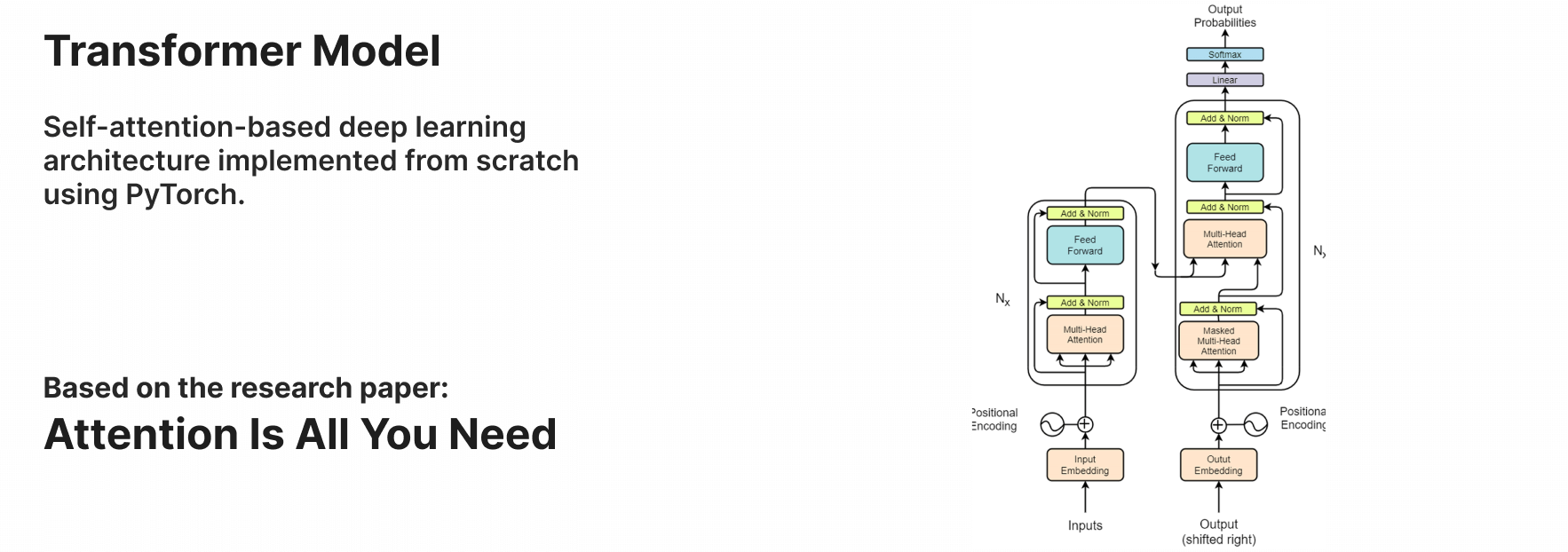Most of the configuration aligned with the configuration proposed in the original research paper. You can play around with this value, specified in the file Config.ini.
- Input-output vector dimension (
d_model) = 512 - Fully connected layer dimension (
d_ff) = 2048 - Total number of head (
head_count) = 8 - Total number of layers (
stack) = 6 - Dropout (
dropout) = 0.1 - Total epoch (
epoch) = 4 - Maximum sequence length (
max_seq) = 90 - Batch size (
batch_size) = 80 - Learning rate (
learning_rate) = 0.0001
The code is structured with proper base architecture, divided into multiple packages. Here's a brief overview of each package.
src: This is the root package for the transformer layer and custom datasets.models: This package consists of sub-packages for different layers of the transformer.embedding: Code for word embedding and positional encoding.encoder: Encoder layer code.multihead_attention: Multi-head self attention layer code.feed_forward: Code for fully connected layer.decoder: Decoder layer code.Model.py: Combine all the sub-packages to build a complete transformer model.
utils: This package consists of helper classes and reusable codes.Config.ini: Model configurations are specified in this file.train.py: This module is responsible for the training of the model.inference.py: This module is for prediction i.e. translation in our case.data: Consists of a raw data file which is used to train our model.checkpoint: Model state and other data are saved in this directory after each epoch.saved: Contains final trained state of the transformer.
Here, this model is primarily developed for language translation purposes. It is trained with english-nepali.xlsv open datasets, comprising pairs of English and their corresponding translated Nepali sentences. The model is trained on a machine equipped with 16GB RAM (cuda disabled) over a duration of 9 hours. The final training loss is around 2.01. To gain a higher accuracy rate, you can train this model with high-quality large datasets over multiple epochs, leveraging high computing resources.
- Clone and open this project in your favorite IDE.
- (Optional) You can create a virtual environment to run this code.
Install libraries that are specified in the requirements.txt file.
pip install -r requirements.txtIf you want to train this model with your data, then follow the given steps. (Otherwise, you can skip this step)
- Paste your data file inside
datadirectory. - Modify the
__getitem___function within theCustomDatasetclass of theDataset.pymodule. - Change the
loadData()function of thetrain.pymodule to load and preprocess your data. - Specify your source and target language code (Spacy) in the
Spacy_Languagesection ofConfig.ini.
Train the model by running the logic defined in the train.py module.
py train.py- During training, for every epoch, we will be preserving the model state and other additional data in the
checkpointdirectory. This is done to ensure that we can recover and resume training in the case of a system crash or any other uncertain circumstance. - After the completion of the training, we are also saving model sate, optimizer sate, and other relevant data in the
saveddirectory, which we are going to use later for prediction in the production environment.
Before executing this step, you need to complete the training of the model because the final prediction will be done using the model state, which is saved during the training process.
py inference.pyhttp://www.apache.org/licenses/LICENSE-2.0
Copyright 2024 Puskal khadka
Licensed under the Apache License, Version 2.0 (the "License");
you may not use this file except in compliance with the License.
You may obtain a copy of the License at
http://www.apache.org/licenses/LICENSE-2.0
Unless required by applicable law or agreed to in writing, software
distributed under the License is distributed on an "AS IS" BASIS,
WITHOUT WARRANTIES OR CONDITIONS OF ANY KIND, either express or implied.
See the License for the specific language governing permissions and
limitations under the License.
